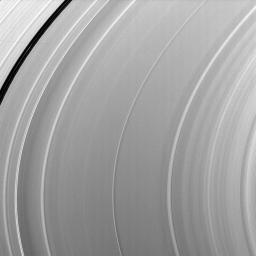
|
Shadow and a Wave
- Click the image above for a larger view
- Full-Res JPEG (1016 x 1016) (148.8 kB)
- Full-Res TIFF (1016 x 1016) (1.0 MB)
Caption:
The very faint shadow of the moon Atlas stretches across the top left of this image while a wave undulates across the A ring in the lower right of this image, which was taken around the time of Saturn's August 2009 equinox.
The wave, seen here as narrow light and dark zones, is the Iapetus -1:0 nodal bending wave first seen in Voyager images from 1980 and not reported again until the 2009 equinox (see PIA11670 ). This bending wave has a long wavelength and a low amplitude that make it difficult to see except under equinox illumination. This nodal wave is the result of a resonance in which the precession rate of the ring particles' orbital planes (the "nodal precession") is in resonance with the orbit of the moon Iapetus. To learn more about bending waves observed in Saturn's rings, see PIA10501 .
The novel illumination geometry that accompanies equinox lowers the sun's angle to the ringplane, significantly darkens the rings, and causes out-of-plane structures to look anomalously bright and cast shadows across the rings. These scenes are possible only during the few months before and after Saturn's equinox, which occurs only once in about 15 Earth years. Before and after equinox, Cassini's cameras have spotted not only the predictable shadows of some of Saturn's moons (see PIA11657 ), but also the shadows of newly revealed vertical structures in the rings themselves (see PIA11665 ).
This view looks toward the northern, sunlit side of the rings from about 15 degrees above the ringplane.
The image was taken in visible light with the Cassini spacecraft narrow-angle camera on Aug. 15, 2009. The view was obtained at a distance of approximately 1.8 million kilometers (1.1 million miles) from Saturn. Image scale is 10 kilometers (6 miles) per pixel.
Background Info:
The Cassini-Huygens mission is a cooperative project of NASA, the European Space Agency and the Italian Space Agency. The Jet Propulsion Laboratory, a division of the California Institute of Technology in Pasadena, manages the mission for NASA's Science Mission Directorate, Washington, D.C. The Cassini orbiter and its two onboard cameras were designed, developed and assembled at JPL. The imaging operations center is based at the Space Science Institute in Boulder, Colo.
For more information about the Cassini-Huygens mission visit http://saturn.jpl.nasa.gov/ . The Cassini imaging team homepage is at http://ciclops.org .
Cataloging Keywords:
| Name | Value | Additional Values |
|---|---|---|
| Target | Saturn Rings | A Ring, Atlas, Iapetus, Saturn |
| System | Saturn | |
| Target Type | Ring | Planet, Satellite |
| Mission | Cassini-Huygens | Voyager |
| Instrument Host | Cassini Orbiter | |
| Host Type | Orbiter | Flyby Spacecraft |
| Instrument | Imaging Science Subsystem (ISS) | |
| Detector | Narrow Angle Camera | |
| Extra Keywords | Grayscale, Shadow, Visual, Wave | |
| Acquisition Date | ||
| Release Date | 2009-10-26 | |
| Date in Caption | 2009-08-15 | |
| Image Credit | NASA/JPL/Space Science Institute | |
| Source | photojournal.jpl.nasa.gov/catalog/PIA11609 | |
| Identifier | PIA11609 | |
